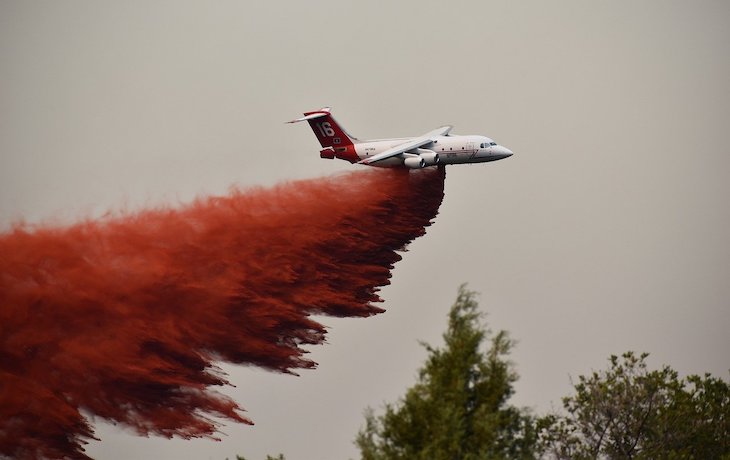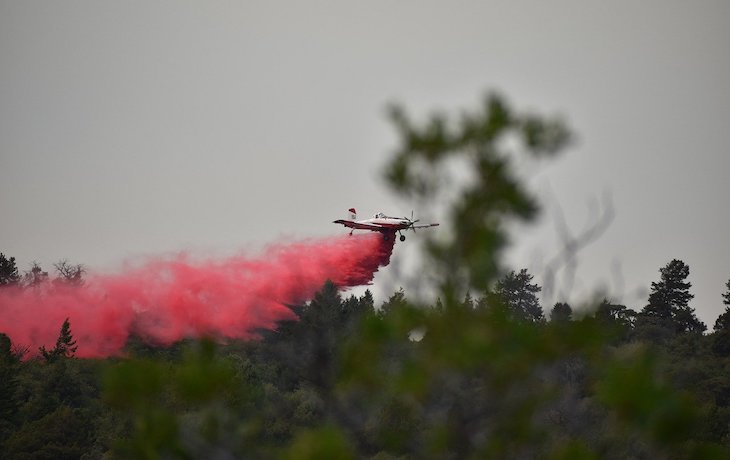Until society figures out better ways to handle the ever-worsening wildfire problem, we’ll continue to see planes dropping impressive plumes of chemicals in an effort to control the fire’s spread.
But what do the planes actually drop? Is the fire retardant harmful to people, animals, or the environment? How do you clean it up if the plane dropped chemicals on your property?
Summary:
- PHOS-CHeK is the most common spray. It’s ~90% water with some fertilizers and “secret sauce” chemicals making up the rest. They add iron oxide (ie. rust) because the red color stands out better than others.
- The retardant spray doesn’t directly extinguish fires. It’s more about creating a firebreak to slow/stop an oncoming fire, as if the firefighters are creating fences to contain or redirect the main fire.
- PHOS-CHeK is generally not hazardous to humans or animals unless it’s consumed. So skin contact is easily solved, while you should throw out any contaminated food or drinking water.
- Wash the spray off any of your property, but don’t use a power washer as that can forcefully embed the chemicals into your house paint, etc.
- As we rely on these sprays more and more, especially closer to developed areas, the chances for water contamination are meaningful. Most portable basic water filters probably won’t be enough to remove those chemicals if you have to drink that water.
What’s in those red clouds?
There are a few different products used, but the most common is PHOS-CHeK. Originally developed by Monsanto in the 1960s, it has since gone through a series of owners. PHOS-CHeK is actually an entire product line, but in practice many people just use it as the label for the common red spray.
85-95% of the cloud is water. The active ingredient is ammonium phosphate or ammonium polyphosphate, both of which are commonly used in fertilizers. Much of the rest of the mixture is a trade secret.
The red stuff? That’s simply iron oxide (also known as rust) used for coloring so pilots can easily see where they’ve deposited the PHOS-CHeK.
“We’ve tried yellow, white, blue, every other color you can think of, and red is about the only thing you can see. Everything else just blends in,” Edward Goldberg, chief executive of Phos-Chek maker Perimeter Solutions, told the LA Times.
How is PHOS-CHeK used?
PHOS-CHeK isn’t used to extinguish fires, but rather acts as a fire break. An environmental survey of PHOS-CHeK describes it as follows:
The retardant solution is applied on threatened vegetation in the form of a chemical firebreak in front of an approaching fire. This solution coats the fuel and then, as the fire gets closer and the water contained in the retardant solution evaporates, the fire retardant component reacts with the cellulose present in the woody material, grass, needles and other matter which normally provide fuel for the fire. (The water contained in the fire retardant solution functions only as a carrier for the fire retardant, evaporating before arrival of the fire and, consequently, contributing little in terms of fire retardancy.) As heating continues, the fire retarded material decomposes giving off water vapor that cools the fire and leaves behind a black, graphite-like, non-flammable carbon coating which both insulates and restricts air flow to any residual fuels. When this occurs, the intensity of the fuel-starved fire decreases and control is much easier to achieve.
So the coating causes the outside of trees and other fuel to carbonize (turn to charcoal) instead of burning bright and hot, which causes the tree to release some of the natural water it has inside, cooling things down. It’s kind of like putting armor around the fuel while misting the surrounding area with water.
Some argue that the fire retardants don’t really work, or at least work well enough to justify their environmental impact. That’s the position of both Timothy Ingalsbee of Firefighters United for Safety, Ethics, and Ecology and Andy Stahl of Forest Service Employees for Environmental Ethics. Both told Gizmodo that the “bombings” act more as an impressive display of force than an actual solution.
Some also argue that letting the fire burn would be best, especially wildfires not near residential developments. Some Native American tribes have complained that fire prevention actually disturbs the natural cycles they depend on for their traditional subsistence. Stahl also argues that the United States Forest Service fights too many small fires, which makes larger, harder-to-control fires all but inevitable.
Is fire retardant hazardous to people or animals?
PHOS-CHeK is generally safe for humans. It can be a respiratory irritant when in powder form, just as any powder can. It can cause skin irritation and dryness, which can be solved by washing it off with soap and water and applying a moisturizer.
But you wouldn’t want to be directly under a drop. “Getting hit by a 500-gallon water balloon… that’s what it would be like to get hit by a direct drop,” Dan Turner, executive director of Cal Poly San Luis Obispo’s Wildland-Urban Interface Fire Institute, told the LA Times.
Ingesting PHOS-CHeK is a different story — throw out any food that’s been exposed, and fill in / drain any pools of water where animals may drink from. British Columbia, Canada, says that if accidentally ingested that first aid is probably not required, but you should contact poison control or a doctor.
Does PHOS-CHeK affect the environment?
The environmental impact of fire retardants is more controversial. Given that it’s basically fertilizer, there is some concern that it could disrupt ecosystems. But the effects have been poorly studied. One 2005 study found that a single application killed some plants while encouraging weeds:
A single application of Phos-Chek did not appear to significantly change species composition or projected foliage cover of the major life forms of native heathland vegetation. However, it did cause whole plant and shoot death of key species Allocasuarina paludosa, Banksia marginata, Leptospermum continentale and L. myrsinoides, and was observed to affect other species. The fertilising effect of the fire retardant generally increased shoot growth of the key species but did not significantly increase the overall height of these species. The application of fire retardant enhanced weed invasion, particularly when supplied at higher concentrations.
The salts in the fertilizer could also harm plants. But, considering the alternative of being burnt, it’s kind of a wash.
The much larger concern is what fire retardants do to waterways. Federal regulations prohibit the spreading of fire retarded within 300 feet of waterways. But accidents happen, and we expect accidental water contamination to increase as the number of wildfires grows.
In 2002, for example, over a thousand pounds of retardant was dropped on Fall River in Oregon. That killed 22,000 trout. A 2014 study by scientists at the National Marine Fisheries Service found that fire retardants are deadly to salmon.
“Studies show that a single retardant drop directly into a stream may cause a sufficient ammonia concentration in the water to be lethal to fish and other aquatic organisms,” Jennifer Jones of the United States Forest Service told the San Gabriel Valley Tribune.
But perhaps the biggest threat is that the fertilizers in fire retardant can cause overgrowth of algae, most notably toxic blue-green algae (which isn’t an actual algae, but cyanobacteria). In 2016, it killed a golden retriever in less than 30 minutes. It’s been suspected in the recent death of a Northern California family, which has led to river closures.
What does PHOS-CHeK do to drinking water?
Drinking water contamination is less of a concern than the broader environmental impact. Generally, contamination from the wildfire itself is worse than from the fire retardant. A 2005 study found that fire retardants had a minimal effect on surface water quality. The two things to be aware of from fire retardant use are nitrate contamination and algae.
Nitrate is more of a problem in groundwater than municipal water. It’s tasteless and odorless, so the only way to detect it is laboratory testing. Formula-fed babies are most at risk. High concentrations of nitrates in the blood cause a condition called “blue baby syndrome.”
Your first line of defense should always be a good quality water filter that filters chemicals. Many home water filters like those from Berkey, Alexapure, and St. Paul Mercantile filter chemicals to some degree. However, most portable water filters only filter bacteria and biological threats, not chemicals. And you want to always have stored water on hand for when you can’t get water from the tap or the water is too contaminated to filter. Check out the water survival skills course for more on how to handle these kinds of extreme situations.
Flame retardants used on furniture are known for numerous health risks, such as hormonal disruption and decreased fertility. But those are different chemicals than are used in fire retardants like PHoS-CHeK, which doesn’t have any known long-term health impacts.
My house was sprayed with fire retardant. How do I clean it off?
NBC Los Angeles offers some tips for cleaning off fire retardant. In short, spray it with a hose, but not a pressure washer, because the pressure washer could embed the chemical in surfaces. A soft-bristle brush can also help. On its own, it’ll fade in sunlight in a few weeks. Also throw out any food that may have been contaminated.



You are reporting the comment """ by on